April 23, 2019
Gleanings
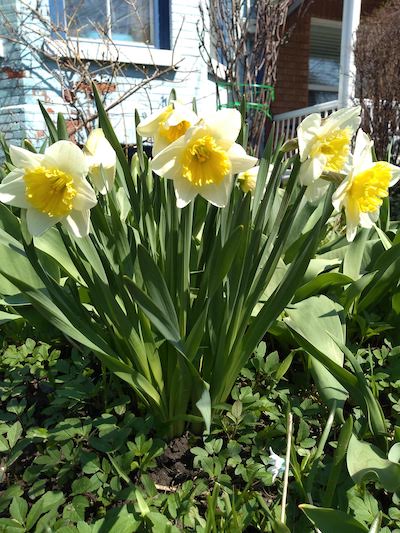
- Maybe this failure has left a space for something new
- We know our children so well, their every mood and whim, each and every freckle on their cheeks. So, to see them out in the world is precious, because it’s a perspective we rarely get.
- I found myself hovering between the twilight of a life and the exciting beginning of another, brimming with light, song, spring, migratory restlessness.
- I am so grateful to all the people who motivate me to make, who celebrate the mistakes, are inspired by them, even, and who choose to bring my heartfelt creations into their homes.
- Once the shoot appears, you don’t abandon it and binge watch Deadwood (though I do recommend that latter). You tend it, adjust what needs to be adjusted, water it, care for it, sing Flock of Seagulls’ songs to it.
- Search widely, write courageously, and be open to possibility.
- So I’ve been baking bread, off and on, for a very long time. I’ve grown and learned a few tricks along the way.
- You will find writers who will argue quite fiercely for what an essay is or isn’t. I’m more interested in what it can be.
- April was showering in earnest today, but it did not deter sufficient numbers of readers from carefully bundling up their books and reading devices and meeting for our largest gathering of silent book club devotees to date…
Do you like reading good things online and want to make sure you don’t miss a “Gleanings” post? Then sign up to receive “Gleanings” delivered to your inbox each week(ish). And if you’ve read something excellent that you think we ought to check out, share the link in a comment below.
April 18, 2019
Points of My Own
(Some items I would object to were I the “Dark Haired Beauty With Big Dark Eyes” immortalized in Bob Seger’s 1976 song “Night Moves”)
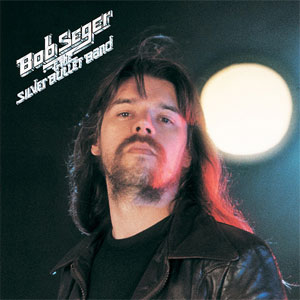
- You were not “a little too tall.” That is not even a thing. Admittedly, yes, you were not particularly well, built, but it’s not like I’d write a song about your peculiar physique and turn the weird shape of your anatomy into the stuff of musical legend. Cuz, like, that isn’t something you and I would do to each other, right? Oh, wait.
- You never got to second base. Anyone who listens carefully to the song will understand this. If you had got to second base, you would have known that my breasts weren’t pointy, or even particularly firm. I understand that it was 1962, and brassieres back then were a bit like armour, but there was nothing pointy about it. This wasn’t Madonna in a cone bra. I don’t even know what this is about. And the way you dwell on their height, when you yourself are still going on about how you’re too tall—you realize this makes me sound like I had tits growing out of my neck, right? Just stop it. It’s weird and embarrassing.
- Your pants were tight, but not because of fashion. They were also really short and we used to call you “Floods”—but once again, I never wrote a song about that to humiliate you.
- You sang, “I used her, she used me, but neither one cared.” I cared, Bob. I did. I liked you, which is why I kept going on dates with you in futile hope that you might take me somewhere that was NOT the “the backroom, the alley, the trusty woods.” The woods were creepy, Bob. Out past the cornfields, it’s downright terrifying, and I thought maybe we could go out for a milkshake, or go see a movie, and you’d tell me, “Relax, babe,” and I kept doing what you told me because my dad was abusive and I was unaccustomed to challenging male authority.
- The most solid proof I’ve got that my breasts weren’t actually pointy is that I never stabbed you with one of them.
- You were not a bad guy. You never made me do anything I didn’t want to do. And that I feel grateful now all these years later for the fact that I was never sexually violated in the backseat of your ’60 Chevy makes me feel depressed, Bob, about the culture we grew up in.
- I wasn’t using you. Seriously, what exactly would I have been using you for? I thought we had something. I was flattered that you liked me. I thought the other kids were mean when they made fun of your pants, and I felt a bit sorry for you. I never used you. And if I had used you, well—and you know where this is going—I wouldn’t have written a song about it. Because that would not be very respectful.
- Sometimes I wonder if you ever figured out that breasts aren’t pointy.
- I don’t know what “front page drive-in news” is, but of all the things I wasn’t trying to make back then, this definitely was it. Which was why we kept going out beyond the cornfields where the woods got heavy, because if people had found out that we were necking in your Chevy, my reputation would have taken a beating. So thank goodness you eventually recorded a song about it in 1976, eh, Bob? Just to keep the whole thing really fucking discreet.
- You got this right: we were young and restless and bored. I’ve never been so bored in my life. What I would have given to have you take me to a movie. Honestly, at the movies I probably would have let you touch my boobs. Looking back, I regret that I didn’t, because it would have made a better song.
- I don’t remember any thunder. It was a really dry summer, if I recall correctly. It hardly rained at all.
- Possible songs you were humming from 1962: Mashed Potato Time, by Dee Deep Sharp; Patches, by Dickie Lee; If I Had a Hammer, by Peter, Paul and Mary; Duke of Earl, by Gene Chandler; or Dee Deep Sharp’s most ambitious follow-up Gravy (For My Mashed Potatoes).
- Man, if you thought autumn was closing in in 1976… What is UP with Baby Boomers and premature nostalgia?
- Working on mysteries without any clue. INDEED.
- My favourite song that year was Palisades Park, by Freddy Cannon, about a guy who took his girl somewhere that wasn’t a backroom or an alley. They kiss at the top of a ferris wheel, and I don’t have any details about her breasts, because Freddy Cannon was a gentleman.
April 18, 2019
Troubling a Star, by Madeleine L’Engle
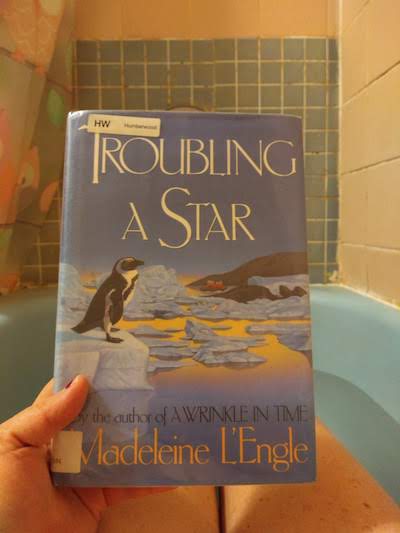
There are only two copies of Madeleine L’Engle’s Troubling a Star in the entire Toronto Public Library system, which made me wonder. The final book in the Austin series, published in 1994 which was 34 years after the series after the series debuted. It begins with Vicky Austin stranded on an iceberg in Antarctica…my hopes weren’t high. And so it was shocking that this was the book of all of them in the series that grabbed me and held me plot-wise, and that I loved it just as much as the other four.
Because while the idea of someone trapped on an iceberg didn’t intrigue me so much narrative-wise, I was all over a plot-driven novel of intrigued concerned with the fictional South American country of Vespugia. Vespugia? I’d not encountered Vespugia within the pages of a book since A Swiftly Tilting Planet, which is my favourite L’Engle novel and the one I’ve read over and over again. In that book, the country is on the brink of nuclear war, and Charles Wallace Murry is called upon to change the past in order to divert it with the help of a unicorn—which he does. By Troubling a Star, however, the country’s benevolent leader has been overthrown and replaced by a dictator, which has changed everything, and suddenly the country is unsafe, police and soldiers everywhere carrying big guns. Like all the books in the series, current events are the backdrop to the story—in 1994 with the fall of the USSR, L’Engle is aware of the precariousness of the new world order (possibly more than many others were at the time) and it makes sense that someone with her understanding of the universe would be able to see the dangers of the vacuum the emerges at the end of the Cold War (“Darkness was, and darkness was good. As was light. Light and darkness dancing together, born together, born of each other, neither preceding, neither following, both fully being in joyful rhythm,” from …Planet).
The story begins with Vicky becoming acquainted with her friend Adam Eddington’s great-Aunt Serena who, with grace and wisdom, fills a void in her life after the recent death of her beloved Grandfather. The family are back in their rural home after their year in New York and the summer of A Ring of Endless Light, and it’s an in-between year for Vicky, who is finishing her final year of high school and is still unsure of her plans for the future. So when Aunt Serena bestows upon Vicky the opportunity to join Adam (a student of marine biology) in Antarctica, she is wild about the idea. Except then she starts getting threatening notes in her locker warning her against the journey, which is very strange, and part of the reason she elects to ignore them.
But things get stranger fast, particularly when she arrives in Vespugia (because the journey to Antarctica is never direct) and begins to suspect that someone has gone through her suitcase, and Adam’s letters from the research station suddenly become cryptic and weird. Everybody travelling with her group begins to look suspicious, and Vicky is no longer sure if there is anyone to trust. Further, chapter begins with a few paragraphs of Vicky stranded on the ice berg, which is great because a) it means not having to read whole chapters about someone stranded on an ice berg and and b) that things for Vicky go so desperately wrong ups the tension and made me want to keep reading to find out how it happened.
A terrible revelation as I was reading this book: it’s uncanny, I’ve said with every one, how each of these novels so imbued with ominous tones of the late 20th century feels so timely now. But maybe it’s less uncanny than just really awful, that nuclear threats, authoritarianism, the omnipresence of dogma, violence and unrest, and chance of mass annihilations all feel so much of this moment: what a time to be alive. Environmental destruction is at the forefront at this book, the hole in the Ozone layer and everything. It anticipates global warming and how important the polar regions are and what bearing they will have on our climate future. And also the brutality and cruelties of nature, and that human beings are very much a part of that. “People who lived, on the surface, ordinary, decent lives also, without any sense of evil, fed other human beings into gas chambers.” In Vespugia, they come across ancient pyramids built by civilizations that were destroyed by colonization. Everything is connected, and nothing about the project of humanity can afford to be taken for granted.
I will admit that I didn’t completely pay attention to the details of the plot here, and some of it’s more than a bit absurd—but not as absurd as The Young Unicorns, which was thoroughly bonkers, so there’s the new standard. I think it’s amazing that this series, which is set in an approximately four year period, was written over 34 years, and manages to encompass massive global events and changes during that time. I know this is supposed to be L’Engle’s series that is doing more conventional things with time (as opposed to Wrinkle…) but it still blows my mind. Plus the ways that this series does (and also doesn’t) map onto the Time Quintet is mind-boggling. Is it the same universe? Are there infinite universes? And what does it mean that we ask these questions about a book that is fiction?
I am going to read The Arm of the Starfish next (which takes place just before A Ring of Endless Light) and then the books in the Polly O’Keefe series, which feature many of the characters I’ve encountered already in the Austin book—and I’m excited about that. The final book in that series is An Acceptable Time, which was published in 1989, which I tried to read years ago with the Wrinkle in Times series, but I see how I might not have appreciated it then. Perhaps I was always meant to wait until I was 40 and had done all the appropriate background reading first.
April 17, 2019
The Centre of the Universe, by Ria Voros

I think I’ve made a pivotal error in my life of late, which is confusing my extreme aversion to badly written coming-of-age novels (“because if you make your character do stupid and inexplicable things, your plot doesn’t even have to make sense!”) with a lack of interest in YA books. And this is not exactly scientific, guys—because I’ve still barely read any YA books—but it’s possible that there is less overlap than I thought between badly written coming-of-age books and YA. Certainly every time I pick up a YA novel (Cherie Dimaline’s The Marrow Thieves, Saints and Misfits, by SK Ali) I come away thinking, “Well, who ever would have thought it? That turned out not to be a badly written coming of age novel after all…” and meanwhile in more Literary pursuits, I keep picking up badly written coming of age books over and over.
So best to stick with the YA, maybe? I picked by The Centre of the Universe, by Ria Voros, after I learned about her amazing literary matchmaking with astrophysicist Elizabeth Tasker, which Voros wrote about on 49th Shelf. Voros had written a novel about a teenage character with a passion for science and astronomy, and wanted to give her character a real-life scientist to look up to, and ended up contacting Tasker (who works in Japan for the Japan Aerospace Exploration Agency) to see what she’d think of appearing in a novel. Turns out that Tasker was game (a strong imagination and ability to see the value of connections is important when one is an astrophysicist, I suspect) and ended up consulting on the novel, providing a Q&A for it, and now is making some tour stops with Voros in Toronto and British Columbia, because her own book (The Planet Factory) has just come out in paperback. They’re going to be at Lillian H. Smith Library next Tuesday April 23 at 6pm, and I thought it sounded like a cool event and something, perhaps, I’d like to take my daughter to.
So I read the book to see—and I really loved it. The story of a seventeen year old girl who’s obsessed with science and feels light-years away from her glamorous superstar journalist mother. And then the distance is made literal when the mother disappears, and Grace has to contemplate the idea that her mother exists outside her own orbit and may have secrets she doesn’t know about. Meanwhile, her best friend is busy organizing fundraisers to support Syrian refugees, and Grace developing feelings for a guy at school who is pretty dreamy and has a passion for photographing butterflies—and what I loved about this book is that all the characters were so interesting and curious, empathetic and intelligent, and while their lives might be complicated, but they’re resilient, and I appreciated the portrayal of strong friendships, as well as the plot’s lack of reliance on cheap tropes (or inexplicable behaviour—see my point above about badly written coming of age novels). I loved that Grace’s parents were interesting people in their own right, with fears and desires, and flaws, and Grace’s struggle to accept that. Plus a plot that kept me turning the pages.
I loved that it’s a book I’ll have no qualms about passing on to my daughter too, who is a bit too young for it—she’s (nearly) ten. But while some of the book will definitely go over her head, I think she will get enough out of it. There’s a sex scene, but it’s pretty tamely written as these things go, and definitely so in comparison to Sidney Sheldon’s The Other Side of Midnight, which was my first exposure to sex in a book, and I wasn’t that much older than she is.
April 16, 2019
For This Moment

After listening to a discussion on Metro Morning about a new poll showing that 42% of Canadians “think there are too many non-white immigrants” coming to this country, we left the house today having a conversation about how baffled we are by people’s attraction to this kind of right-wing populist thinking.
I mean, on one hand I get it—here, there is certainty, as well as apparently enticing conspiracy theories on YouTube. It’s about something to belong to, someone else to blame for our disappointments, easy solutions to difficult problems, and it’s easier to just lock the door altogether rather than do the painstaking work of community. Scapegoating an “other” is a great shortcut to community really, or at least its illusion, keeping people from worrying about the problem of how to get along with the neighbours you’ve already got, the ones whose skin tones are the same as yours. I thought about this a lot when Kellie Leitch was going on about “Canadian values” during her failed run for the PC leadership, and considered how far apart her ideas are from mine about so many things, and yet this country has room for both of us. This, I’ve always figured, is kind of the point of this country.
So I get it, but I still don’t get it, how it might be possible to fall under the spell of this kind of dangerous rhetoric.
“I feel like everything important I’ve ever been schooled in was actually training for this moment,” I told my husband this morning on our walk, who said he felt the same.
And it’s not that either of us grew up with deeply progressive values in our families, or in places that were remotely cultural diverse. But it was in the stories I was raised on about my grandfathers fighting against tyranny in World War Two, and lessons learned from the Holocaust, and even Hiroshima. About the brutality and waste of war, the horrors of genocide, of human beings’ capacity to do evil things others. The dangers of nationalism, Japanese internment camps and an immigration policy that was, “None is too many.” (It would have been Indian Residential Schools too, if we had learned about them in schools, which we didn’t, but now kids do.) It was in “Never Again” and Remembrance Day ceremonies, and the wreaths I watched my grandfather lay at cenotaphs to honour fallen soldiers and freedom and democracy. It was in the Underground Railroad, and the words of Martin Luther King Jr., and the books I read, from The Diary of Anne Frank to The Cat Ate My Gymsuit and Iggie’s House. It was what I learned about the atrocities of history, and the necessity to be our better selves, to stand up against injustice, and the fact that one day we might be called upon to choose one side or another.
Didn’t you also imagine Germany in 1933, what side you would have been on? Didn’t you also say, “I’d never have let that happen”? Do you also look around at this moment and see circles where racism has become acceptable, people with dangerous ideas being elected into office, leaders undermining democratic values and institutions just because they can—and they’re even supported? Abortion bans as a harbinger—honestly, did none of these people read their Paula Danziger? We’ve got to stand up now, simply because we can’t do it any sooner.
April 15, 2019
Gleanings

- Having no food traditions to call my own has suddenly become liberating— something I can use, I hope, to explain to my children the connection between history and freedom and the world they’re growing up in.
- I used to think that I had to leave all sorts of mementos behind for my girls when I died…
- How do we stop judging ourselves? By forgiving ourselves for not being perfect, by letting go of the past and accepting that we did the best we could do under the circumstances…
- Children have value and are deserving of respect, simply because they exist. It matters not that they don’t vote yet nor have an income that translates into purchasing power. The measure of their worth is not any company’s bottom line.
- The ability/ to simultaneously/ write and mother well.
- Instead of making up a clear, concise one-sided narrative and sticking to it, she was admitting an unspeakable, untweetable, politically unpalatable fact: Sometimes, the truth is complicated.
- No woman, dead or alive, could hope to win the nation’s heart by writing about seeking communion in a Kansas bar while her husband drove carpool in El Paso.
- what I find really depressing is the continuing buoyancy of the market for sexist crap
- Learning to balance my to-dos with my no-need-to-do-a-thing-right-now is my new to-do.
- The trick to freezing liquids in a mason jar is simply not to overfill the jar.
Do you like reading good things online and want to make sure you don’t miss a “Gleanings” post? Then sign up to receive “Gleanings” delivered to your inbox each week(ish). And if you’ve read something excellent that you think we ought to check out, share the link in a comment below.
April 12, 2019
Seaside Treasures, by Sarah Grindler
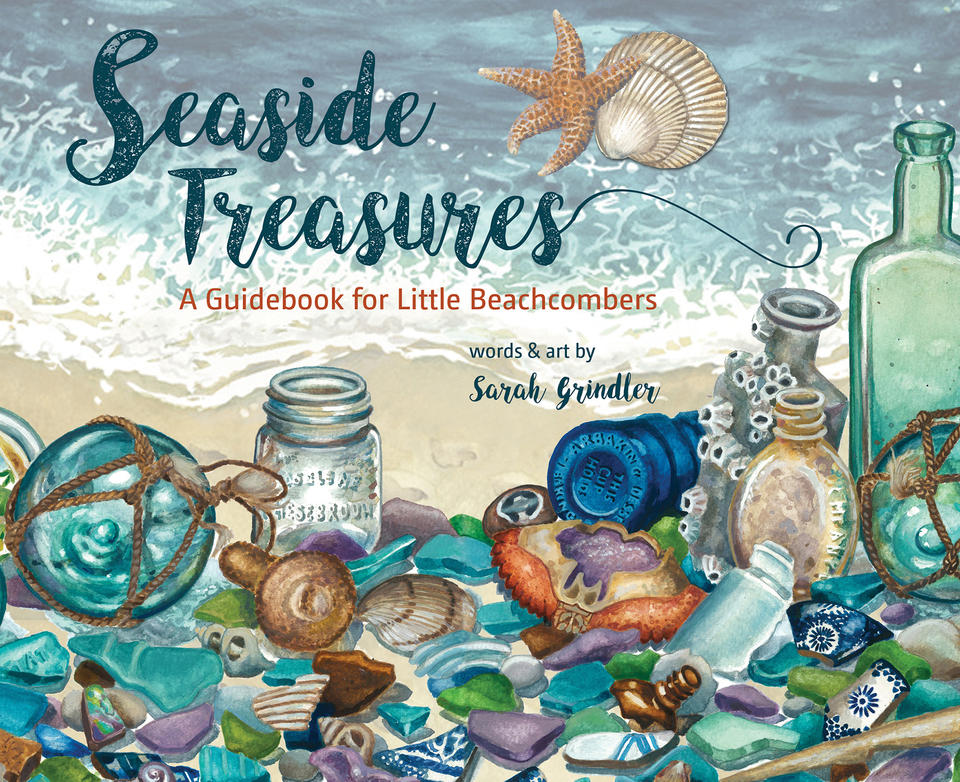
This week has been aggravating for all kinds of reasons, macro and micro, and not least among the troubles is that people kept waking me up at 4am, and thereafter I’d lie awake in bed taking inventory of all the items that are weighing on my mind, which is no way to fall back to sleep, I tell you. So finally I came up with a plan, the night after I first read Seaside Treasures, by Sarah Grindler. My worries, I imagined, put away in a drawstring bag in the place where I was in my mind, which was the beach at Humber Bay Shores, a beach where the beach glass tends to be yellow, which fascinates me because out in the east end of the city it’s mostly green, and I wonder why the distinction. I would leave the bag behind me as I went to explore the beach instead, picking up mussel shells, slate perfect for skipping, round stones to hurl, and others with stripes to admire, the sun sparkling on the surface.
It’s possible I’m just dreaming of summer anyway, mid-April with snowflakes, but Seaside Treasures is a portal to there, and I love it so much. We’re beach treasure enthusiasts in our family, collectors of two glass jars of beach glass so far (and counting), with purple being ever elusive, but the odd fragment of painted china has made up for it in the meantime. And even though our beach is not a seaside, instead by a lake (but still, a GREAT lake) and we will never find a sand dollar or an urchin shell, this book is still right up our street, and makes us excited and inspired to go exploring local beaches again.
Grindler’s realistic painted illustrations are beautiful, a different hue for every page—blue sea glass, then purple—both rare. “Other hard-to-find sea glass colours are red, orange, and yellow You can find pieces of green, brown, and white glass more easily. What is your favourite colour of sea glass?” she asks, in text as engaging as the pictures are. She shows glass fishing floats, arrowheads from the Indigenous people who lived on these lands long before we did, seashells, and also pieces of china. “Do you wonder who might have used them? Perhaps sailors, merchants, or pirates!”
And then there’s garbage, which washes up among the rest of it, which led to a really interesting discussion (and a general consensus that cigarette butts are disgusting). Isn’t it funny that some garbage gets to be treasure and other isn’t? A marble on the beach is treasure indeed, but what about the toy car with its wheels missing? Grindler writes, “When I find garbage, I collect it to help keep our oceans and beaches clean.”
The final spreads invite the reader to search specific objects on a crowded page of beachy treasures, and then to imagine what kinds of art and objects could be made from these objects as well. Ending with a question: “What will you find?”
(Hopefully serenity.)
April 10, 2019
I didn’t rally on Queen’s Park in 1997
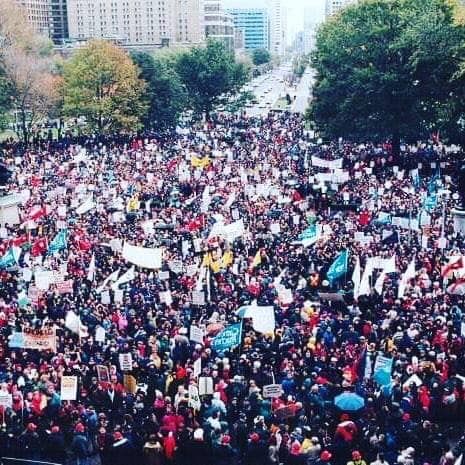
I didn’t rally on Queen’s Park in 1997, the last time an austerity government set its sights upon Ontario’s schools and teachers fought back. In my defence, I was a student in my final year of high school. And if walkouts were being organized, I didn’t notice. I recall thinking that politics shouldn’t concern me; surely the adults could work it out? I didn’t understand that teachers were standing up against policies whose destructive effects would be felt for generations.
And this is not hyperbole. When my child began kindergarten in 2013, elementary schools were very different from what I remembered. Apart from the implementation of full-day kindergarten, it has been decades since major investments were made in Ontario’s education system, a system whose underfunding was signed into law in 1997 when Mike Harris’s government changed the funding formula, the policy my teachers were rallying against.
Which is why these days, teacher-librarians work half-time, if at all. At my kids’ wonderful school, we don’t have a vice-principal, or a music teacher. Parents volunteer in the office to help our lone administrator keep up with her tasks, and they also tutor students in literacy programs. Parent fundraising replaces decades-old gym mats, replenishes classroom libraries, and leads initiatives to redevelop school playgrounds. Education Assistants and other support staff are rare in classrooms, while teachers—carrying on heroically—face growing numbers of students with special needs.
Meanwhile, Ontario schools—literally—are falling apart, facing a growing $15.9 repair backlog. In 2016, thanks to advocacy from grassroots organization Fix Our Schools, the Liberal government committed to $1.1 billion for school repairs, which was a start, but not enough. And then weeks after their election in June 2018, Doug Ford’s Progressive Conservatives eliminated the Cap-and Trade program—“Promises made, promises kept,” Ford and his ministers crowed—the school repair fund disappearing with it.
So this is the system the government is looking to cut from to pay for overpromised tax breaks. When high school students walked out of classrooms on April 4, they were standing against pedagogically unsound ideas including increased class sizes, mandatory e-learning, the elimination of thousands of teachers, and specialized programs and classes. At the elementary level, junior class sizes are rising, teaching staff are being laid off, special grants and programs are eliminated, along with plans to implement Calls to Action from the Truth and Reconciliation Commission into the curriculum, and there has been no additional funding for students who’ve lost support through the province’s autism program.
The students who walked out—the Premier dismissed their organizing as coming “strictly from the union thugs”—are so much more aware of their world than I was at their age.
“I heard about the cuts and I was just kind of mulling it over for the weekend,” said Natalie Moore, 18, who organized the walk-out. “I kind of realized that students, especially as leaders, need to step forward and take it into our own hands.”
And on April 6, two days later, thousands of teachers, parents, children and allies—galvanized by students’ actions days before—would do the same, gathering at Queen’s Park to stand against cuts to schools and this government’s unwillingness to invest in public education.
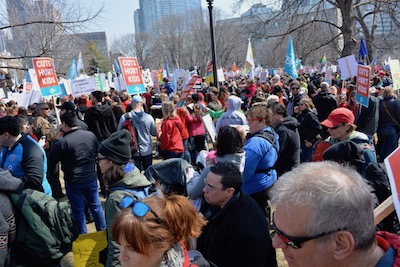
It was another demonstration that Ford and Thompson would write off as a union stunt, but I was there, and I’m not in a union. Neither are my neighbours, my children, their classmates, and parents and grandparents who gathered in a downtown playground on Saturday morning so we could walk to the rally together. We were there to stand with our teachers—our partners in our children’s education—and because we believe in a well-funded education system where every child has a chance to succeed.
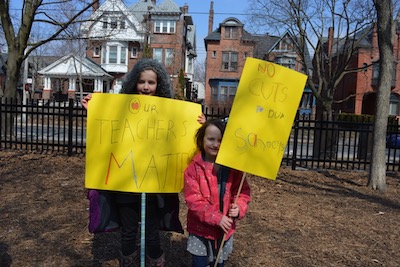
For me there was another reason to rally at Queen’s Park, and it’s to make up for my failure to do so two decades ago. I see a direct line between my inaction then and the ways my children are being let down today. They deserve an education as excellent as the one that I received in Ontario schools, as do all those students who walked out of class last Thursday, those with the courage and conviction to use their voices and stand up for schools, and not simply wait for the adults to work it out.
And we are the adults now. So let’s fight back, and finally be the kind of people that Natalie Moore and all our children can be proud of. They’ve set the most incredible example for us to follow—and we’re proud of them already.
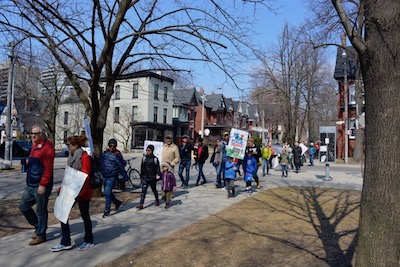
Next steps: Ontario parents with school-age children: the group West End Parents For Public Education Toronto has created an incredible tool kit that we are using at our school to rally together and fight back against the government’s attack on public education. Please take a look at it!
- If you’re on the council at your child’s school, there is lots of practical advice and things to do—and if your council is not political, let me tell you that ours wasn’t either but I’ve found lots of support from my colleagues on council as we take action for our kids.
- If you’re not on council, you can still organize (and possibly the people on your school’s council will be happy someone else is doing it!).
- And if you do not have the time, please reach out to your school’s council and let them know that these issues are important to you and make sure they know about the WEPPE tool kit.
- To those of you whose children go to private schools, I hope your communities will also think of ways to be allies for public schools and support this cause.
An important thing I’ve learned in the last year is that you don’t need to wait for permission to start acting on the issues that are important to you. Please reach out if you have any questions or would like to work together.
April 9, 2019
Canadian Independent Bookstore Day: A Modest Proposal
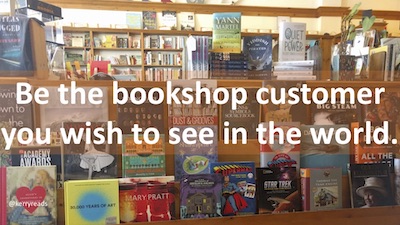
Independent Bookstore Day is an American celebration that takes place on the last Saturday in April, and in 2015 Canadian novelist Janie Chang brought the concept north of the 49th parallel with Authors for Indies Day, which brought authors into bookstores (and there was often cake) to hand-sell their bookish favourites. I took part at a local bookstore the first two years, and then in 2017 I jumped into a van and took off on a bookish road trip, which was epic fun. And in 2018, the project was taken over by the Retail Council of Canada, rebranded as Canadian Independent Bookstore Day. Gone was the author focus, partly because some authors didn’t comprehend the point of being in the bookstore wasn’t necessarily to sell their own books but instead to be fostering book culture (and buying) in general. Partly also (and you should probably sit down, this is going to hurt): the average Canadian author live-in-person doesn’t necessarily turn out a crowd. If you are the exception to this rule, I urge you to get yourself to a bookstore on the last Saturday. Bookstores need crowds. Out the door, popular people. DO IT.
But if you are more like the rest of us, with a respectable career but not (YET) with a cult following, then I’ve got a modest proposal for you. I’m not sure what’s going on with Canadian Independent Bookstore Day this year—the website seems to be down and I’m not even sure what the name is (Independent Bookseller Day in some circles?) let alone the hashtag. But I’ve already been hearing some buzz and in the spirit of projects that rely on community spirit, little work and no overhead (SO my jam), please hear me out.
If you are a Canadian author, and/or anyone who appreciates a vibrant literary culture (who doesn’t?), then head out to an independent bookstore on Saturday April 27 and spend some of your hard-earned cash.
If you have children in your life, bring them too and let them pick out a book or two. If you have people in your life celebrating birthdays in coming months, do your shopping then. If you’re thinking of end-of-year teacher gifts, pick up some gift cards. If you’re being urged toward-self-care from all quarters, buy a big stack of novels you’re dying to read and consider the job done. If you can’t think of what you’d like to read, ask the bookseller for a recommendation (or take my quiz to find your perfect literary match!). If you don’t have much money to spare, buy a paperback kids book for under a tenner. If you don’t have cash to spare at all, you can write your bookseller a thank-you note letting them know you appreciate their place in your community, and go in to drop it off. There might even be cake?
The sole advantage to not having your own local independent bookstore is an excuse for a road trip. Here are some bookshops I’ve come to love on my travels. In a recent Twitter thread, Monique Gray Smith was also sharing some of her favourites. I have found in my experiences that bookstores can often be found in proximity to great places to have lunch…
Writing books or working in publishing is one of the least lucrative jobs a person could spend her life trying to succeed at, but I still think that buying (full priced) books (from businesses that contribute to a healthy literary eco-system) is part of the job description, when you are able. You might be a writer, but you were probably a reader first, and if we aren’t buying books, well, who else is going to? This goes for book bloggers, who may become so inundated with review copies that it’s hard to seek out book purchases. But still, the most surefire way I know to get people buying books is to…go by books myself. (Done and done.) Let’s see how much of an influencer you really are. (Finger crossed: SO MUCH).
Let’s all be the bookshop customers we wish to see in the world! See you on April 27.
“Buy hardback fiction and poetry. Request hardback fiction and poetry as gifts from everyone you know. Give hardback fiction and poetry as gifts to everyone. No shirt or sweater ever changed a life. Never complain about publishing if you don’t buy hardcover fiction and poetry regularly.”– Annie Dillard, “Notes for Young Writers”
April 8, 2019
Gleanings
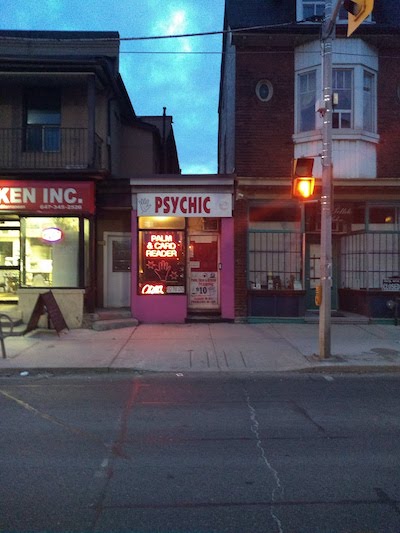
- If you’ve heard me talk about the library, you’ll know that I value the photocopier as one of the unsung heroes of human exchange.
- 17 Strategies of a Born-Again Reader
- It’s time for the men to listen and to record and to stay quiet.
- You get what you get, when you get a child.
- Choose Kindness! Kids Books that Explore This Crucial Value
- But where it comes to that question – the one of whether or not to bring new life onto the planet, by way of my body – I and my presently fertile peers have chronologies to consider beyond our own.
- When I was first diagnosed I turned to Jilly Cooper…
- How an Email to an Astrophysicist Changed My (Book’s) Life
- Think about how things like desolation, sadness, an imbalance in the universe, even, have a way of sharpening us, too
- …we’ve allowed our friendship to steep and stew, to mature; gathering dust at times, shining brightly at others. Never discarded. Complex, still vital, preserved and cherished.
- The water and its glorious buoyancy makes all of us athletes.
- Lord Peter Wimsey, from the beginning
- Although I was often warned about getting Blasenguitar and I understood from the way she said it that it was painful and I would be sorry, she never explained what it was.
Do you like reading good things online and want to make sure you don’t miss a “Gleanings” post? Then sign up to receive “Gleanings” delivered to your inbox each week(ish). And if you’ve read something excellent that you think we ought to check out, share the link in a comment below.





